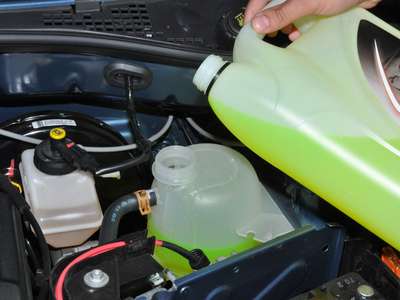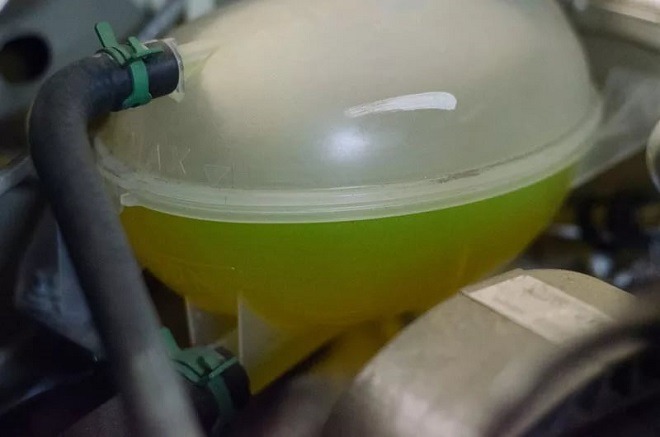
Replacing antifreeze with Renault Logan
Content
Renault Logan coolant should be officially replaced every 90 thousand kilometers or every 5 years (whichever comes first). Also, antifreeze for Renault Logan should be changed in advance if:

- a noticeable change in the properties of the coolant (color has changed, scale, rust or sediment are visible);
- Antifreeze contamination has occurred as a result of an engine malfunction (for example, engine oil has entered the coolant, etc.).
At the same time, you can change antifreeze for Renault Logan yourself in a regular garage. To do this, the waste fluid must be completely drained from the cooling system, rinsed (if necessary), and then completely filled. Read more in our article.
When to change antifreeze for Renault Logan
Some motorists mistakenly believe that Logan's cooling system is modern and does not require frequent maintenance. You can also find the statement that the use of modern types of antifreeze allows you not to change the coolant for 100 thousand km or more.
In fact, the replacement of the coolant must be done much earlier. As practice shows, even the most modern types of antifreeze are designed for a maximum of 5-6 years of active operation, while cheaper solutions serve no more than 3-4 years. In addition, additives in the composition of coolants begin to “wear out”, corrosion protection is lost, and the liquid removes heat worse.
For this reason, experienced specialists recommend replacing the coolant every 50-60 thousand kilometers or 1 time in 3-4 years. In addition, you should monitor the condition of the antifreeze, checking the density, paying attention to color, the presence of rust in the system, etc. If signs appear that indicate a deviation from the norm, it should be replaced immediately (preferably with a full flush).
Renault Logan cooling system: what kind of antifreeze to fill
When choosing a coolant, it is important to keep in mind that there are several types of antifreeze:
- carboxylate;
- hybrid;
- traditional;
These fluids vary in composition and may or may not be suitable for certain types of engines and cooling systems. We are talking about antifreeze G11, G12, G12 +, G12 ++ and so on.
Since Renault Logan is a fairly simple car in terms of design, Renault Logan antifreeze can be filled in as original for Logan or Sandero (brand 7711170545 or 7711170546):
- Renault Glaceol RX Type D or Coolstream NRC;
- equivalents with RENAULT specification 41-01-001/-T Type D or with Type D approval;
- other analogues such as G12 or G12+.
On average, these coolants are designed for 4 years of active operation and protect the cooling system well. For example, in the case of Renault Logan, high-quality antifreeze from well-known manufacturers G12 or G12 + is very well compatible with the engine block of this model and the materials from which parts of the cooling system are made (thermostat, radiator, pipes, pump impeller, etc.).
Logan antifreeze replacement
On the Logan model, the correct replacement of antifreeze means:
- drain;
- washed;
- filling with fresh fluid.
At the same time, it is necessary to flush the system, since when draining into the block and hard-to-reach places, the old antifreeze (up to 1 liter), rust particles, dirt and deposits partially remain. If these elements are not removed from the system, the new fluid will quickly become contaminated, shorten the life of the antifreeze, and reduce the efficiency and reliability of the entire cooling system.
Considering that Logan can have several types of engines (diesel, gasoline of different sizes), some replacement characteristics may differ depending on the type of internal combustion engine (the most common gasoline units are 1,4 and 1,6).
However, the general procedure, if it is necessary to replace Logan antifreeze, is in many ways the same in all cases:
- prepare about 6 liters of ready-made antifreeze (concentrate diluted with distilled water in the required proportions of 50:50, 60:40, etc.);
- then the car must be driven into a pit or put on a lift;
- then let the engine cool down to an acceptable temperature to avoid burns and injury;
- taking into account the fact that there is no drain plug on the Renault Logan radiator, you will need to remove the lower pipe;
- to remove the tube, the engine protection is removed (6 bolts are unscrewed), the left air spring of the engine (3 self-tapping screws and 2 pistons);
- having gained access to the pipe, you need to substitute a container for draining, remove the clamp and pull the hose up;
- note that low profile clamps can be removed with tools and are also more difficult to install. For this reason, they are often replaced with simple good quality worm-drive clamps (size 37 mm).
- while the antifreeze is draining, you need to unscrew the plug of the expansion tank and open the air release valve (it is located on the pipe going to the stove).
- you can also blow the system through the expansion tank (if possible) to drain all the antifreeze;
- by the way, there is no drain plug on the engine block, so it is optimal to drain the coolant as carefully as possible using available methods; After draining, you can install the pipe in place and proceed to flush or fill in new antifreeze. Fully filling the liquid, the engine should be warmed up, make sure the system is tight and check the coolant level again (the norm is between the “min” and “max” marks on a cold engine);
- it may also be necessary to remove air pockets from the system. To do this, open the plug on the expansion tank, set the car so that the front is higher than the back, after which you need to actively turn off the gas at idle.
- Another way to remove air is to open the air outlet, close the reservoir cap and warm up the engine again. If everything is normal, the system is tight, and the stove blows hot air, then the Renault Logan antifreeze replacement was successful.
How to flush the cooling system on Logan
Depending on the degree of contamination, as well as in the case of switching from one type of antifreeze to another (it is important to take into account the compatibility of the compositions), it is also recommended to flush the engine cooling system.
You can do this wash:
- the use of special flushing compounds (if the system is contaminated);
- the use of ordinary distilled water (a preventive measure to remove the remnants of the old liquid);
The first method is suitable if rust, scale and deposits, as well as clots, have appeared in the system. In addition, a “chemical” flush is performed if the deadlines for the planned replacement of antifreeze have not been met. As for the method with distilled water, in this case, water is simply poured into the system.
First, the old antifreeze is drained, a pipe is laid. Then, pouring the drain through the expansion tank, you need to wait until it comes out of the air outlet. Then liquid is added, the normal level in the tank is “fixed” and the plug of the expansion tank is screwed on. We also recommend reading the article on how to change the gearbox oil for Renault Logan. In this article, you will learn about the features of changing the oil at the Logan checkpoint, as well as the nuances that should be considered when replacing gear oil with Renault Logan.
Now you can start the engine and wait for it to warm up completely (circulation in a large circle through the radiator). Also, while the engine is warming up, periodically increase the engine speed to 2500 rpm.
After the engine is fully warmed up, the liquid has passed through the radiator, the power unit is turned off and allowed to cool. Next, the water or laundry is drained. When draining, it is important to keep the water clean. If the drained liquid is dirty, the procedure is repeated again. When the drained liquid becomes clean, you can proceed to the filling of antifreeze.
Recommendations
- When replacing antifreeze with flushing, remember that after draining, about a liter of liquid will remain in the system. If the system has been flushed with water, this must be taken into account when diluting the concentrate and then adding antifreeze.
- If a chemical flush was used, such a flush is first drained, then the system is flushed with water, and only then antifreeze is poured. We also recommend reading the article on how to flush the oil system before changing the engine oil. In this article, you will learn about the available ways to clean the engine lubrication system.
- To check for the presence of airbags in the system, the stove is turned on when the car is hot. If the coolant level is normal, but the stove cools down, it is necessary to remove the air plug.
- After short trips in the early days, check the level of antifreeze. The fact is that the level can drop sharply if air pockets remain in the system. Sometimes it happens that after replacing the antifreeze, the driver may detect certain malfunctions in the cooling system. For example, leaks may occur. This happens if deposits clog microcracks; however, after chemical flushing is used, these natural "plugs" are removed.
You may also encounter the fact that after unscrewing and reinstalling the expansion tank cap, it does not relieve pressure in the system, the valves in the cap do not work. As a result, antifreeze flows out through the cap. To avoid such problems, it is better to change the expansion tank cap every 2-3 years or always prepare a new one before replacing antifreeze.
